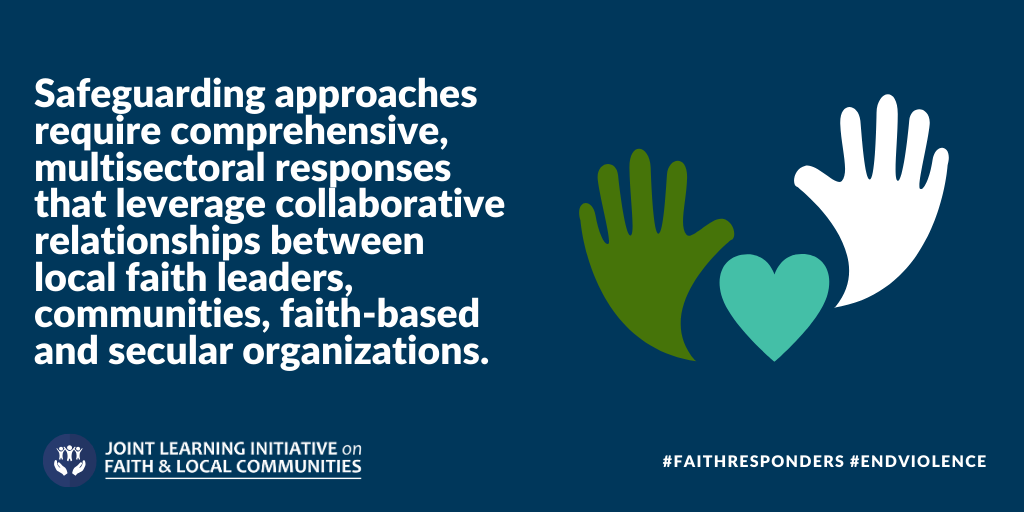
Faith communities can improve their safeguarding approaches to violence against children by identifying gaps in understanding of child protection policies within their faith institutions. Faith institutions can implement standards and protocols that clarify how to appropriately interact with children, how to foster safe and child-friendly environments, and how to report cases of child abuse to the proper authorities.
This page presents examples and resources that demonstrate how faith actors and communities are working to improve their safeguarding approaches.
In one of their communities, they [religious and traditional leaders] stopped the tradition of FGM/C and they came up with a modern FGM/C whereby, because what they were saying is the girls want that celebration and say, if they grow up and get married without going through that celebration people in the community will say, you are not a real woman. So what they did, they organised the celebration but without the circumcision. All the girls will go there and it works very well, both sides were happy. (UV, working with Christian, Muslim and Traditional communities, Tanzania)
Practice Examples:
Example 1: Creating Safe Environments for Children: A Toolkit for Safeguarding Children & Protecting them from Harm
- Organization: VIVA: Together for Children
- Project: This toolkit consolidates material developed by VIVA’s worldwide network. The toolkit looks at creating safe environments for children and protecting them from harm, from a Christian perspective.
- Results: An example of successful implementation of the program includes CRANE, a partner network of VIVA in Kampala, Uganda. CRANE used the toolkit to build staff capacity, establish a child protection committee, and develop a child protection referral system for their members. Another example is Pastor George Kaniike, who was trained as part of the Keeping Children Safe program and developed a child protection committee within his church in Mukino District, Kampala. He contacted community leaders in neighboring villages and more than 30 villages in the surrounding area established CP committees of their own.
- Find the full toolkit here.
Example 2: Good Touch Bad Touch Toolkit
- Organization: Chab Dai Coalition
- Project: The Good Touch Bad Touch Flip-Chart project was developed by Chab Dai in order to communicate about sexual abuse and exploitation in a creative and child-friendly way to school-aged children in Asia. The story presented through the flip charts teaches children how to protect themselves and report sexual abuse if it occurs.
- Results: After the flip chart was developed, it was used in schools and with NGOs. The flipchart also includes a one-day training program that prepares those who will deliver the session to facilitate discussions that follow the flipchart presentation. The evaluations of the flip chart have not yet been published.
- Find the Flipchart here.
Example 3: Mennonite Church Committee Dove’s Nest Program
- Organization: Mennonite Church Committee (MCC)
- Project: The MCC in the US conducted a survey in order to identify gaps in understanding of child protection practices within MCC institutions. This led to the MCC board approving a child protection framework that requires all MCC institutions to have and comply with policies and procedures and likewise requires the same for all external partners of MCC. The Dove’s Nest program was developed to support congregations to develop policy, write guidelines, and help implement child protection safeguarding measures within their given institutions.
- Results: The program included aspects from health and safety in facilities to monitoring staff and volunteers after hire, and reporting issues to authorities. Procedures include topics such as ensuring there are windows in doors so that adults are not alone with youth without visibility, that first aid kits are available, that certain hazardous materials (like cleaning chemicals) are stored safely, that background checks are done, training is provided including how to report issues to authorities, that staff and volunteers are monitored and that children’s responses to adults working with them are observed. While many procedures in other institutions noted background checks as important, the literature on Dove’s Nest highlighted the policy that background checks should be formal (legal) and informal – seeking feedback from informal.
- Read more in JLI’s Scoping Study. (Rutledge, K. and Eyber, C. 2019, pg. 28) or visit the Dove’s Nest website here
Related Resources:
See Scoping Study’s next key message
Haga clic aquí para español

